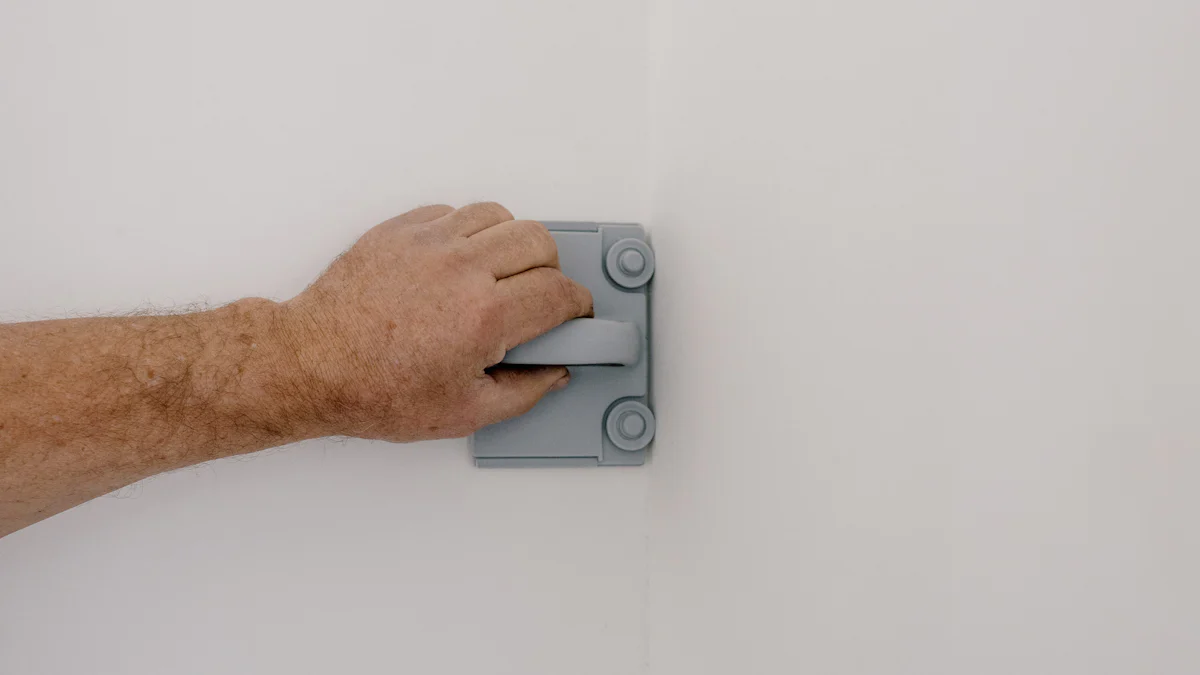
Zinc handles dominate the bathroom fittings market, with over 95% of faucet handles made from zinc alloys. Their popularity stems from affordability and versatility. Zinc alloys cost half as much as copper and are easier to mold. These qualities make them a practical choice for durable and stylish bathroom designs.
Key Takeaways
- Regularly inspect your zinc handles for signs of wear, such as scratches or wobbling, to catch issues early and save on repairs.
- Use the right tools, like screwdrivers and pliers, to easily adjust and maintain your zinc handles, ensuring they remain functional and stylish.
- Clean your zinc handles weekly with mild soap and dry them thoroughly to prevent corrosion and maintain their appearance.
Identifying Quality Issues in Zinc Handles
Common problems with zinc handles
Zinc handles are durable, but they can develop issues over time. One common problem is loosening, which often occurs due to frequent use or improper installation. Misalignment is another issue that can make the handle difficult to operate. Corrosion or discoloration may also appear, especially in humid environments. These problems not only affect the functionality of your bathroom fittings but also their appearance.
Tip: Regularly inspect your zinc handles to catch these issues early. Early detection can save you time and money on repairs.
Signs of wear and tear
You can identify wear and tear by looking for visible damage. Scratches, fading, or peeling of the surface coating are clear indicators. Handles that feel wobbly or make unusual noises when turned may also show signs of internal wear. Over time, these small issues can escalate, leading to complete handle failure.
Note: If you notice any of these signs, address them promptly to maintain the efficiency of your bathroom fittings.
How to spot loose or misaligned fittings
Loose or misaligned fittings are easy to detect. A loose handle will often wobble when touched, while a misaligned one may not sit flush against the surface. You might also notice difficulty in turning the handle or uneven gaps between the handle and its base.
To confirm, gently move the handle and observe its movement. If it shifts more than expected, it’s likely loose. Misalignment can be spotted by checking if the handle is crooked or tilted.
Pro Tip: Use a level tool to check alignment for a more precise assessment.
Tools and Materials for Adjusting Zinc Handles
Essential tools for adjustments
To adjust zinc handles effectively, you need the right tools. A screwdriver set is indispensable for tightening screws or removing loose components. Choose a set with both flathead and Phillips screwdrivers to cover various handle designs. An Allen wrench is another essential tool, especially for handles secured with hex screws.
You should also have a pair of pliers on hand. Pliers help you grip and manipulate small parts, making adjustments easier. A small adjustable wrench is useful for tightening nuts or bolts that secure the handle. For precise alignment checks, a bubble level ensures accuracy.
Tip: Keep these tools in a dedicated toolbox to avoid misplacing them during repairs.
Recommended materials for repairs
Certain materials are crucial for repairing zinc handles. Thread-locking adhesive prevents screws from loosening over time. Use a non-corrosive lubricant to ensure smooth handle operation. Silicone sealant is ideal for sealing gaps and protecting against moisture.
If corrosion has damaged the surface, touch-up paint designed for zinc alloys can restore the handle’s appearance. Replacement screws or washers are also handy for addressing worn-out components.
Pro Tip: Always choose high-quality materials to enhance the durability of your bathroom fittings.
Optional items for enhanced maintenance
For long-term maintenance, consider investing in a microfiber cloth for cleaning. It prevents scratches while removing dirt and grime. A rust remover can help tackle early signs of corrosion. Protective wax or polish adds a layer of defense against moisture and wear.
You might also find a small handheld vacuum useful for cleaning hard-to-reach areas around the handle. These optional items simplify upkeep and extend the lifespan of your zinc handles.
Note: Regular maintenance with these items keeps your bathroom fittings looking and functioning like new.
Step-by-Step Guide to Fixing Zinc Handles
Tightening loose handles
Loose handles can make your bathroom fittings feel unstable. Start by locating the screws securing the handle. Use a screwdriver or Allen wrench, depending on the screw type, to tighten them. Turn the tool clockwise until the handle feels secure. Avoid over-tightening, as this can strip the screw threads or damage the handle.
If the screws continue to loosen over time, apply a thread-locking adhesive. This adhesive keeps screws in place and prevents future loosening. Allow the adhesive to dry completely before using the handle again.
Tip: Test the handle after tightening to ensure smooth operation without wobbling.
Fixing alignment issues
Misaligned handles can disrupt the functionality of your bathroom fittings. To fix this, loosen the screws slightly without removing them. Adjust the handle until it sits flush against the surface. Use a bubble level to confirm proper alignment. Once aligned, tighten the screws securely.
For handles with persistent alignment problems, inspect the mounting hardware. Replace worn-out washers or screws to achieve a stable fit.
Pro Tip: Mark the correct alignment position with a pencil before tightening to save time.
Addressing corrosion or discoloration
Corrosion and discoloration can diminish the appearance of zinc handles. For regular cleaning, use a sponge or microfiber cloth with non-acidic dish soap. To remove oxidation, scrub gently with the scratchy side of a sponge. For alkaline spots, mix baby powder and milk, then scrub with a nylon toothbrush.
Natural cleaning products like table salt, hydrogen peroxide, or plain white vinegar can also be effective. Always dry the handle thoroughly after cleaning to prevent further discoloration. Avoid harsh solvents or abrasive cleansers, as they can damage the zinc coating.
Note: Store zinc hardware in an air-tight manner to minimize oxidation risks.
Replacing damaged parts
If a handle is beyond repair, replacing it is the best option. Begin by removing the screws or bolts securing the damaged handle. Carefully detach the handle from its base. Take the old handle to a hardware store to find a matching replacement.
Install the new handle by aligning it with the base and securing it with screws or bolts. Tighten them evenly to ensure a snug fit. Test the handle to confirm proper functionality.
Tip: Choose a replacement handle made from high-quality zinc alloy for durability and style.
Maintenance Tips for Long-Lasting Bathroom Fittings
Cleaning methods to prevent corrosion
Regular cleaning is essential to keep your zinc handles free from corrosion. Use a sponge, paper towel, or microfiber cloth with mild, non-acidic dish soap for everyday cleaning. For alkaline spots caused by hard water, mix baby powder with milk and scrub gently using a nylon toothbrush. Natural cleaning products like table salt, hydrogen peroxide, or plain white vinegar can also work effectively.
Always dry the handles thoroughly after cleaning to prevent oxidation. Avoid harsh solvents or abrasive cleansers, as they can damage the zinc coating. Applying a thin layer of furniture wax can add an extra layer of protection against fingerprints and moisture.
Tip: Clean your bathroom fittings weekly to maintain their shine and prevent long-term damage.
Lubrication tips for smooth operation
Lubrication ensures your zinc handles operate smoothly. Use a non-corrosive lubricant, such as silicone-based spray, to reduce friction. Apply a small amount to the moving parts of the handle and wipe away any excess with a clean cloth.
For older handles, inspect the internal components before lubrication. Remove any dirt or debris that could interfere with the lubricant's effectiveness. Regular lubrication prevents squeaking and extends the lifespan of your bathroom fittings.
Pro Tip: Lubricate your handles every three months for optimal performance.
How to protect zinc handles from moisture damage
Moisture is one of the biggest threats to zinc handles. To protect them, ensure proper ventilation in your bathroom. Use a dehumidifier or exhaust fan to reduce humidity levels. Applying a silicone sealant around the base of the handle can prevent water from seeping into the fittings.
Avoid leaving water droplets on the handles after use. Wipe them dry with a microfiber cloth to minimize the risk of moisture damage.
Note: Regularly check for leaks in your bathroom fittings to prevent water accumulation around the handles.
Regular inspection and upkeep
Frequent inspections help you identify potential issues before they escalate. Check for loose screws, misalignment, or signs of wear and tear. Tighten any loose components immediately to maintain stability.
Inspect the surface for scratches, discoloration, or corrosion. Address these issues promptly using the cleaning and repair methods mentioned earlier. Regular upkeep ensures your bathroom fittings remain functional and visually appealing.
Tip: Schedule a monthly inspection to keep your zinc handles in top condition.
Adjusting and maintaining zinc handles becomes effortless when you use the right tools and techniques. Early issue detection ensures your bathroom fittings stay functional and stylish.
Take Action: Apply these tips today to enhance your bathroom's durability and appearance. A little effort now guarantees long-lasting, hassle-free fittings.
FAQs
How often should you clean zinc handles to prevent corrosion?
Clean your zinc handles weekly using a mild dish soap and a microfiber cloth. Regular cleaning prevents dirt buildup and reduces the risk of corrosion.
Tip: Dry the handles thoroughly after cleaning to avoid moisture damage.
Can you fix a misaligned zinc handle without professional help?
Yes, you can. Loosen the screws, adjust the handle, and tighten them securely. Use a bubble level to ensure proper alignment for a professional finish.
What should you do if a zinc handle keeps loosening?
Apply thread-locking adhesive to the screws after tightening them. This adhesive prevents future loosening and ensures the handle remains stable during regular use.
Pro Tip: Allow the adhesive to dry completely before using the handle.
Media Contact
Company Name: Dezheng Sanitary Ware Co., Ltd
Email: Send Email
Address:No. 669 Songpu Road, Binhai Economic Development Zone
City: Cixi City
State: Zhejiang Province
Country: China
Website: https://www.dz-sanitary.com/

